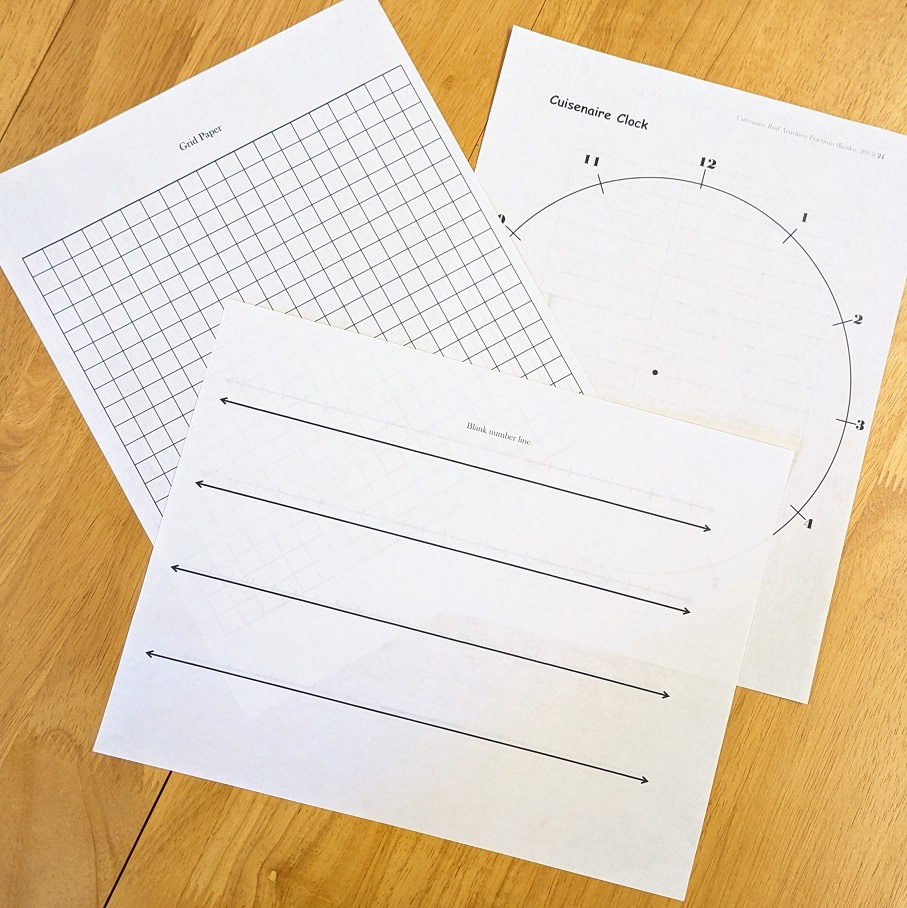Overview
One of the most effective ways to make use of manipulatives (either from your makerspace or purchased) is to use paper-based resources to help scaffold the mathematics you are wanting to represent. Here are several paper-based resources that can be downloaded and used in various ways.

List of Files
There are two options for creating fraction tiles: plastic (3D printer) and foam (Cricut). Below are estimates for the amount of material, along with recommended color schemes. The estimated costs are conservative estimates and you may be able to find less expensive filament or foam sheets.
IMPORTANT NOTE: For any printable that is used with a manipulative (grid paper, clock, number lines), when you print the pdf print it as “ACTUAL SIZE” (the default is often “shrink to fit” and if you set it this way the printout will not match the size of the concrete manipulative).
- Centimeter Grid Paper: To be used with any centimeter based manipulative (array rods, Cuisenaire rods, base 10 blocks)
- Dot Array Paper: To be used with multi-digit multiplication and division. The dot array paper includes smaller 10×10 arrays (for easier grouping by place-value for students) composing a 50×60 grid. Can be used on its own with pencil, or within a sheet protector with dry-erase markers.
- Number Lines: These are extremely useful for fractions, addition/subtraction, and other operations to have students use centimeter-based manipulatives to measure distances on the number lines.
- Vertical Number Line: This is useful for printing multiple copies, taping together and then laminating a longer number line that students can use various centimeter based manipulatives to operate (array rods, Cuisenaire rods, base 10 blocks).
- Manipulative Clock: Originally designed for use with Cuisenaire rods, this can also be used with Array Rods and other centimeter based manipulatives. It is most useful to focus on using only the 1s and 5s from the given manipulative.
- Fraction Wholes (for Fraction Tiles): These can be used with the fraction tiles found on this site for when you wish for students to work with multiple whole numbers (such as 6 divided by 3/4). It allows for a paper-based reference that can be drawn on, cut up, etc. to pair with the manipulatives.
- 10×10 Squares: These 10cm by 10cm squares can be used with place value blocks, array rods, fraction squares, etc. to scaffold various content.
- Decimal Squares: Often referenced in curriculum textbooks (but without providing the actual resource), decimal squares allow for a visual representation of whole number squares with different decimal parts (tenths, hundredths, & thousandths).
- Multiplication Fact Fluency Cards (Level 1, Level 2, Level 3, Level 4): These cards have an array on one side and the multiplication fact (& answer) on the other side. They are designed so that the child can easily see groups of 5s & 10s in the arrays and work off these patterns to begin learning (meaningfully) their multiplication facts and strategies. These cards are grouped by level that multiplication facts are easiest to learn: Level 1 (2s, 5s, 10s), Level 2 (3s & 4s), Level 3 (6s, 7s, 8s, 9s), and Level 4 is optional (11s & 12s).
Examples of Use
Number Lines
Descriptions / videos forthcoming.
More to come…
